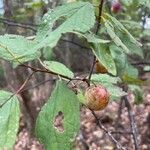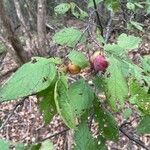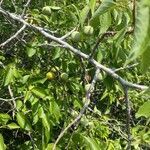Shrubs or trees, suckering, 15–80 dm, moderately thorny. Twigs with axillary end buds, usually hairy, sometimes glabrous. Leaves deciduous; petiole 4–19 mm, usually hairy on adaxial surface, sometimes on both surfaces, rarely glabrous, usually eglandular, sometimes glandular distally, glands 1–2, ?discoid?; blade usually elliptic, broadly elliptic, or obovate, rarely ovate, 5–11 × 2–5.5 cm, base usually cuneate to obtuse, sometimes rounded, margins ?coarsely?, doubly serrate, teeth sharp, eglandular, apex usually abruptly acuminate, rarely acute, surfaces glabrous or sparsely hairy along main veins. Inflorescences 2–5-flowered, umbellate fascicles. Pedicels (4–)8–20 mm, usually glabrous, sometimes hairy. Flowers blooming before or at leaf emergence; hypanthium obconic, 2.5–5 mm, usually glabrous, sometimes hairy, externally; sepals broadly spreading to reflexed, ovate to lanceolate, 2–3.5(–5) mm, margins entire or irregularly or obscurely glandular-toothed, sometimes 2-fid at apices, ?ciliate?, abaxial surface glabrous or hairy, adaxial tomentose; petals white, oval to oblong-obovate, 7–12 mm; ovaries glabrous. Drupes red, orange, or yellowish, ?glaucous?, subglobose to ellipsoid, 15–30 mm, glabrous; mesocarps fleshy; stones ovoid, strongly flattened. 2n = 16.
More
Shrub or small tree to 8 m, spreading from the roots and forming thickets; lvs obovate to obovate-oblong, usually somewhat hairy beneath, 6–l0 cm, abruptly and sharply acuminate, acute to obtuse at base, sharply and coarsely (often doubly) serrate, the teeth spreading or antrorse, acuminate, 1–2 mm, glandless but tending to have a callous point; petiole mostly glandless; fls 2–4 in an umbel; pet white, 10–15 mm; sep often pubescent on the upper side, often distally toothed, glandless or with a few very obscure glands; fr red to yellow, glaucous, 2–3 cm thick; stone compressed; 2n=16. Moist woods, roadsides and fence-rows; N.H. to Man. and Mont., s. to n. Fla. and Okla. May, June.
A small tree. It grows 8 m high and spreads 3.5 m wide. The leaves are oval and usually widest slightly below the middle. They are 6-10 cm long and 3-4.5 cm wide. They are fully rounded at the base. There are sharp teeth along the edge. The leaves are dull green with slightly sunken veins above. They are paler and with some hairs near the veins underneath. The flowers are white and about 25 mm across. They are on slender greenish-brown stalks. They occur in small flat topped clusters. The fruit are 20-25 mm long. They are orange or red and the surface is slightly powdery. The flesh can be sweet or sour. There are several named cultivated varieties.
Rich soils in mixed deciduous woodland, by streams, on the borders of swamps and in hedgerows. Thickets, moist soil, roadsides, fence rows, margins of woods, stream banks; at elevations from 10-2,100 metres.
More
Temperate. It grows in deciduous woodlands. It is often along the banks of rivers and lakes. It suits hardiness zones 3-9.




